Blogs
Online Share Trading in Nepal: How to buy and sell shares in Nepal?

Online share trading is done in the secondary market. The secondary market is the platform where buyers and sellers meet each other to buy and sell shares virtually. Online share trading is done through the TMS (Trade Management System) account, accessible on devices such as laptops and smartphones. Online share trading in Nepal is performed from 11 am to 3 pm, 5 days a week (From Sunday to Thursday), with exceptions on national holidays. Before involving in online share trading you must have the following things:
- Basic Requirements for Share Trading
- Basics things to know before starting investment in Share Market
Having basic requirements and basic knowledge are not sufficient to succeed in the share market. You must have technical analysis and fundamental analysis skills to analyze market trends and future predictions. However, In this blog, you will learn the step-by-step process of Online Share Trading in Nepal.
Login to your TMS account
Every broker has a unique Broker number provided by the NEPSE. If you don’t know your broker number you can select it from the list of brokers in Nepal with the TMS URL we have listed on our site.
STEP 1: Log in to your TMS account.
The URL format for TMS login: https://tms[Broker number].nepsetms.com.np/login. Example: Broker number 58, the URL for this broker is https://tms58.nepsetms.com.np/login.
STEP 2: Your TMS login page will appear as below. Enter the Client Code/ User Name, password, and Captcha correctly. Click login
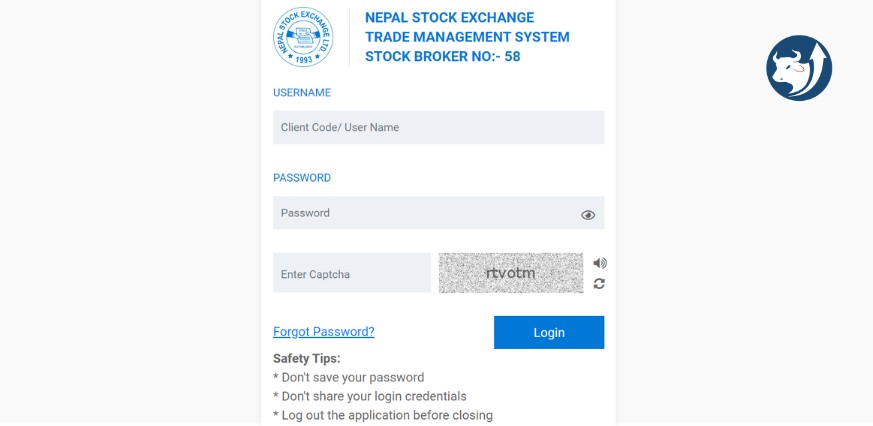
STEP 3: After login, you will see “NEPSE TMS DASHBOARD” as below.
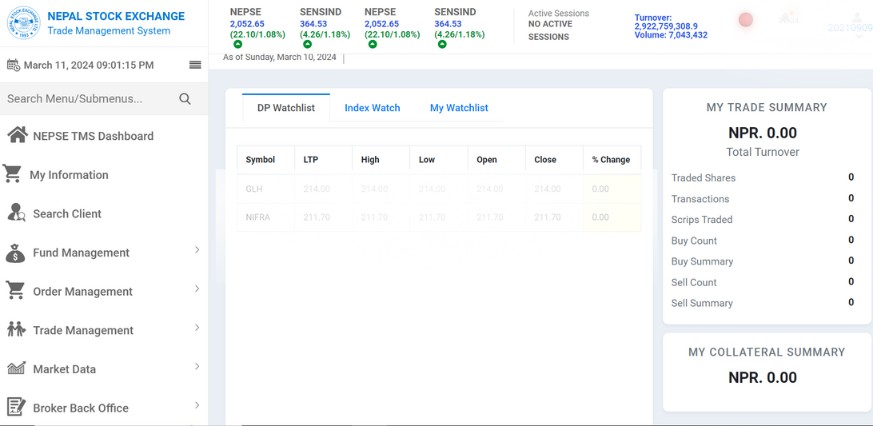
How to start online share trading in Nepal/buy and sell shares?
To buy and sell shares, go to “Order Management” → Click “Buy/Sell” below screen will appear. To purchase shares click “BUY” If you want to sell click “SELL” on the top right corner of the page.

How to buy shares online?
To buy shares online follow the given steps:
STEP 1: A blue dashboard will appear as shown below after clicking on the “BUY” button.
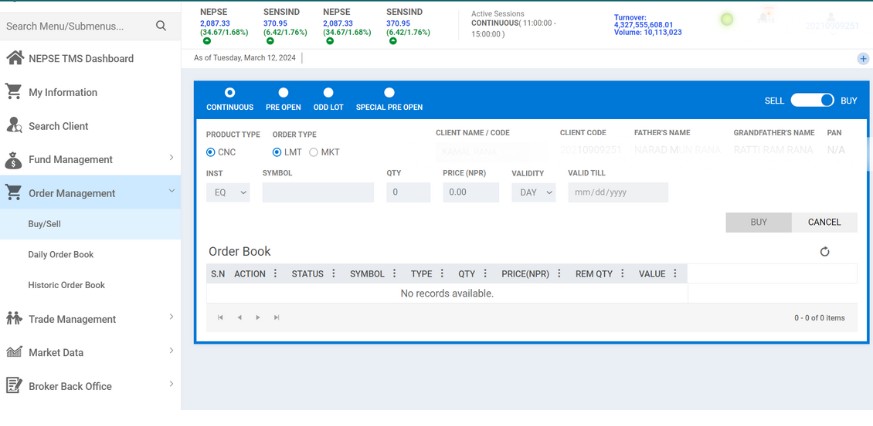
STEP 2: While placing a buy order you can place an order in two ways Limit order and Market order.
- Limit order: In limit order, you can set a price on which you prefer to buy the share. If any seller places a sell order at the same price, then your order will execute.
- Market order: Market order is where you buy shares from the market instantly at the best price available if the desired amount of shares are available.
STEP 3: There are two options “LMT- Limit Order” and “MKT- Market Order” under the “Order Type“. let’s place a limit order.
Now enter the symbol or name of the institute in the “SYMBOL” section. Enter the quantity of the Share Under “QTY”, and enter the price under the “PRICE” section as shown below. Click the “BUY” button.
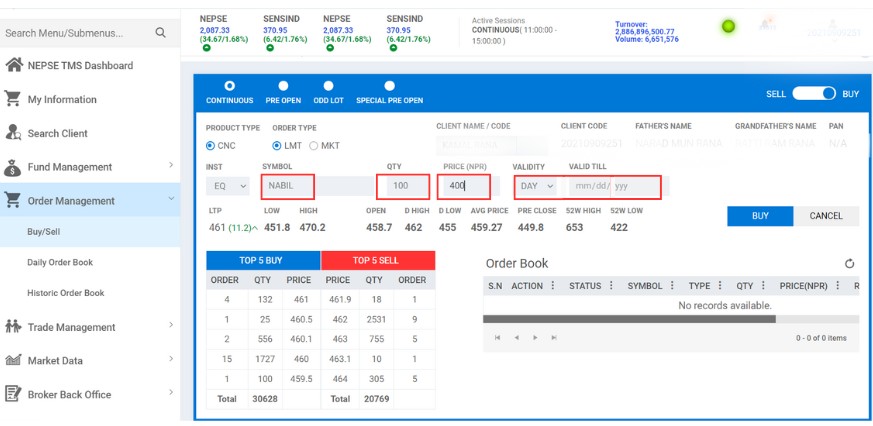
STEP 4: When you click “BUY” you will get a notification on the top right corner of the screen “New order request has been successfully placed” as shown in the image.
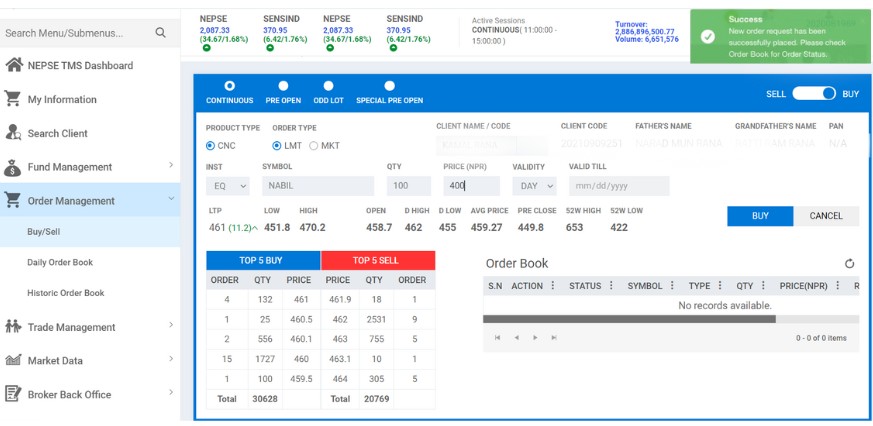
Note: If you have chosen a limited order, remember that placing an order doesn’t mean you have purchased shares. Your shares will be bought only if any seller places the sell order at your price and also meets the quantity of shares willing to buy.
It will take 2-3 days to transfer the share to your account you can check it from the Meroshare account.
How do you sell shares online in a TMS account?
NOTE: Before selling shares check how many shares you have, Click “Broker Back Office” → “DP Holdings”. Now you can see the quantity of your shareholding as shown in the image below.
It is important because “if you place a sell order for more shares than you own, you will face a closeout penalty. Therefore, you must complete EDIS after selling the shares. If the amount is insufficient during the eDIS repayment, a 20% penalty of the total amount will apply.”
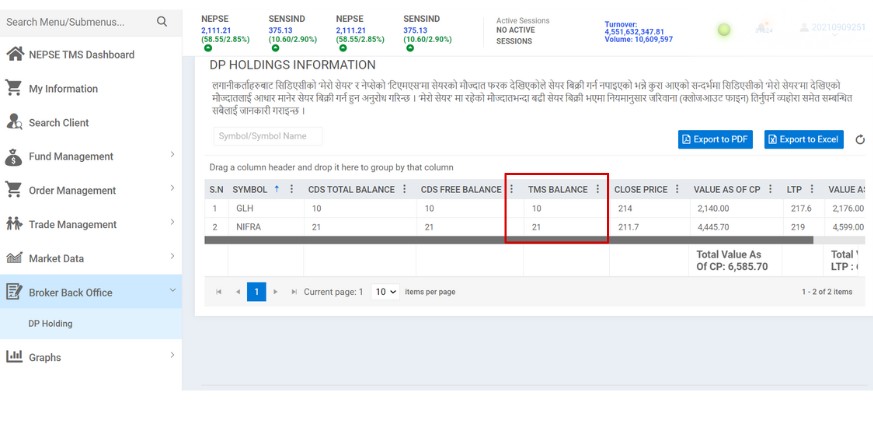
Step 1: After you click on the sell button a red TMS dashboard will appear as shown below. To buy shares online you must have collateral in your account. You can load Collateral in your NEPSE TMS account if there is no collateral.
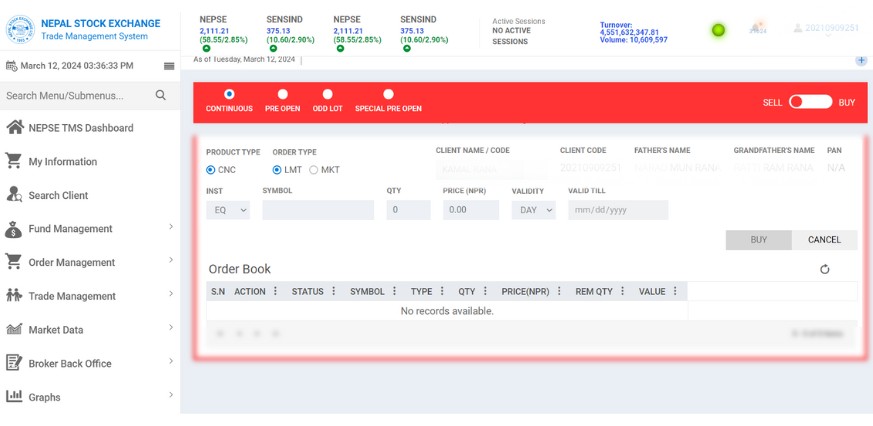
STEP 2: Enter the Symbol of the institution you want to sell under “SYMBOL”, quantity, and enter the price of the share for sale.

STEP 3: As shown in the image the table consists of two sections: “TOP 5 BUY” and “TOP 5 SELL”.
The blue table shows the data for buy orders and the red table shows the data for sell orders placed with different quantities and prices.
In the first row, 4 buy orders are placed for 132 units of shares, asking price is 461 and in the same row, 1 sell order is placed for 18 units of shares at the price of 461.9.
STEP 4: Suppose you own 200 units/kitta shares of Nabil Bank. If you place a sell order at the highest asking price at that time i.e. Rs. 461/kitta then your sell order will be executed instantly and your shares will be sold. Alternatively, if you set a higher selling price than the asking price, your sell order will remain open for the day until the order is executed. When your order matches a buying price, your shares will be sold. After selling the shares don’t forget to perform the EDIS i.e. transferring the shares to the buyer.
You may also like:
- Common mistakes to avoid when trading stocks
- How much should you pay as broker payment
- Basics to know before starting investment in Share Market
FAQs
What is stock market trading?
Stock market trading involves the buying and selling of shares from publicly traded companies in NEPSE to gain profit from price fluctuations. Through trading, you can own a portion of a company and potentially earn money as its value increases. At the same time, trading carries risks and requires careful research and strategy.
How to sell penny stocks?
To sell penny stocks, follow these steps:
- Open a brokerage account.
- Log in to the trading platform.
- Place a sell order by specifying the quantity and desired price.
- Review and confirm the sell order.
- Monitor the transaction for execution.
Can I sell shares without a broker?
Yes, you can buy or sell shares without a broker by using a direct stock purchase plan (DSPP). The company’s transfer agent manages the transaction in this process.
Best online brokers for stock trading?
Many brokers can help you with share trading, you can find the best broker in Nepal based on customer service, responsiveness, and investment skills.
When to sell stocks?
You can sell stocks in the following situations:
- when you’ve reached your profit target.
- When there’s a significant change in the company’s fundamentals, or if the stock becomes overvalued.
- When external factors impact the stock’s performance or if it falls below your predetermined loss limit.
Where can I buy and sell stocks?
You can buy and sell stocks through online brokerages, traditional brokerage firms, and direct stock purchase plans (DSPP).
Blogs
Private Power Producers Protest ‘Take and Pay’ Provision in Budget
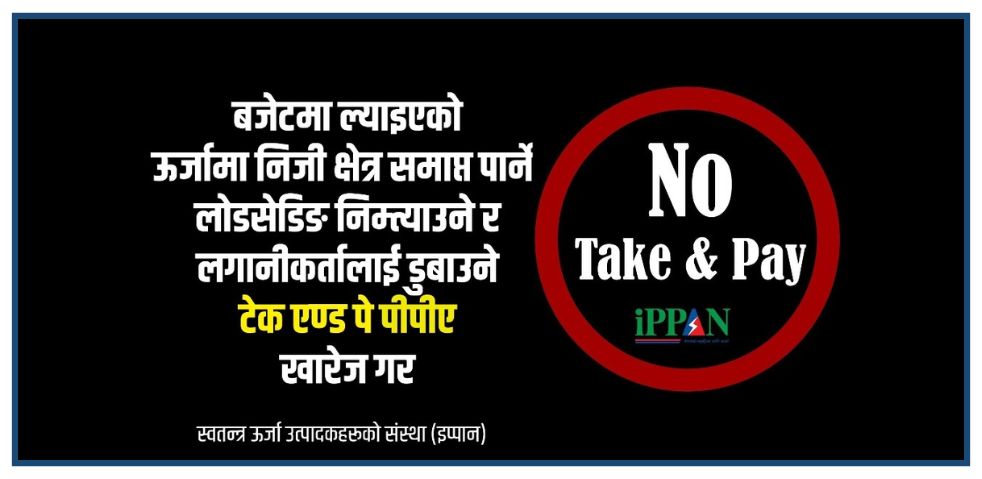
Private energy entrepreneurs in Nepal have taken to social media, protesting the government’s decision to introduce the ‘Take and Pay’ (Liu Ra Tir) system for electricity purchase agreements (PPA) in the new fiscal year budget.
Under this system, the government would only pay for the electricity it uses, instead of paying for the total electricity generated by hydropower projects. Entrepreneurs argue this move could severely hurt the private sector, discourage investment, and push the country back toward power shortages.
Online Campaign Targets Top Officials
Energy producers are now directly appealing to key government figures. They have publicly tagged Prime Minister Pushpa Kamal Dahal, Finance Minister Barshaman Pun, Energy Minister Shakti Bahadur Basnet, and NEA Executive Director Kulman Ghising on social media, urging them to withdraw the Take and Pay provision.
This digital campaign comes just days after developers handed over a memorandum to the Prime Minister and bombarded top officials with hundreds of SMS messages requesting the same.
Why Are Entrepreneurs Worried?
Entrepreneurs claim that this decision will:
- Weaken the private sector’s role in the energy industry
- Risk the return of load-shedding (power cuts)
- Causes financial losses to investors
- Damage the overall economy
The Independent Power Producers’ Association of Nepal (IPPAN) has strongly opposed the provision. According to IPPAN’s Vice President and protest coordinator Mohan Kumar Dangi, the policy shift will discourage private hydropower development, especially for Run-of-River (RoR) projects, which are most affected by the new model.
Ongoing Protests and Next Steps
Since Asar 6, private power developers have been staging a phase-wise protest. On the third day of their movement, they moved their campaign to social media to raise public awareness and pressure the government.
Dangi warned that if the government ignores these peaceful efforts, the protests will escalate. Planned steps include:
- Lobbying political party leaders in Parliament
- Launching a nationwide street protest
- Returning the keys of privately built hydropower projects to the government — a symbolic act of handing over control
Background: The Budget Controversy
The controversy started when the budget for FY 2082/83 (announced on Jestha 15) stated that all future PPAs for RoR hydropower projects would be done under the Take and Pay model only. This was a major change from the previous Take or Pay model, where producers were paid even if electricity wasn’t consumed, offering more security for private investors.
Conclusion
The ‘Take and Pay’ decision has sparked serious concerns across Nepal’s private energy sector. Developers fear this could lead to a slowdown in future hydropower investments, and possibly, a return to unstable electricity supply. With pressure mounting both online and offline, the government’s next move will be critical for the future of Nepal’s energy landscape.
Blogs
Nepal Rastra Bank to Withdraw NPR 60 Billion from the Banking System on Monday
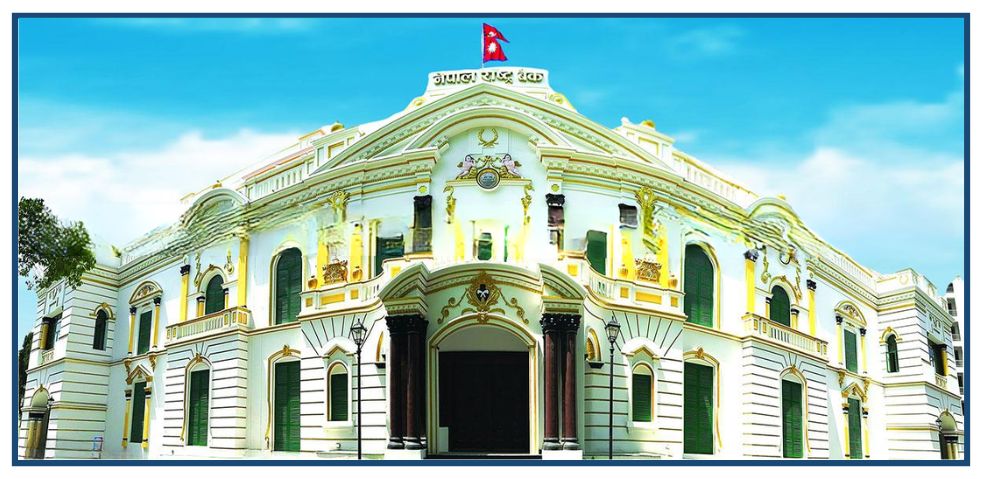
Nepal Rastra Bank (NRB), the central bank of Nepal, has announced it will withdraw NPR 60 billion in deposits from the banking system on Monday through a deposit collection auction. This move comes as excess liquidity continues to remain in the banking sector since the beginning of the current fiscal year 2081/82.
According to NRB, the withdrawal will be conducted through the online bidding system, and the interest rate will be determined through competitive bidding. The collected amount, including both principal and interest, will be settled on Shrawan 18, 2082 (August 2, 2025).
Key Auction Details
- Total Amount: NPR 60 billion
- Minimum Bid Amount: NPR 100 million
- Bid Increments: Must be divisible by NPR 50 million
- Eligible Participants: Class ‘A’, ‘B’, and ‘C’ licensed banks and financial institutions
- Auction Method: Competitive bidding via NRB’s online platform
- Maturity & Settlement Date: Shrawan 18, 2082
Why Is the Central Bank Taking This Step?
As per NRB, the banking system is currently holding excessive liquidity, with total deposits crossing NPR 7 trillion. However, this liquidity is not being effectively utilized, as loan disbursement has remained slow. This reflects a lack of investor confidence and limited credit demand in the economy.
To control liquidity and stabilize the financial market, NRB has been consistently withdrawing funds using monetary tools since the start of the fiscal year. Tools like reverse repo, outright sale, deposit collection, and bond issuance are being used depending on the situation, whether there is too much or too little money in the system.
Recent Trends in Liquidity Control
Last week alone, NRB withdrew NPR 90 billion in a single day, highlighting the ongoing efforts to manage surplus liquidity. The central bank is using such actions not only when there is an overflow of money but also in times of shortage, to maintain balance in the financial system.
Conclusion
The decision to withdraw NPR 60 billion on Monday shows that Nepal Rastra Bank is actively managing liquidity to ensure financial stability. With a large amount of unused funds in the system, these measures are crucial to prevent inflation, reduce financial risk, and encourage more effective use of capital in the economy.
Blogs
52-Week Low & High Microfinance Shares in Nepal: Current Status and Future Outlook

The microfinance sector in Nepal has been moving sideways for a long time. The group sub-index has been fluctuating between 4,600 and 5,600. Recently, the index reached a swing high of nearly 4,900 but then closed at 4,671.74.
The national budget did not bring any immediate changes that could affect the capital market. So, investors are now waiting for the upcoming monetary policy. After the newly appointed Governor of Nepal Rastra Bank, Dr. Bishwanath Paudel, reduced the risk weight on margin loans from 125% to 100% during the third quarterly review, investor confidence grew.
Investors now hope that the following changes will be introduced in the next monetary policy:
- Removal of the current Rs. 15 crore limit on individual investment
- Removal of the 15% dividend cap on microfinance institutions
- Permission for banks and financial institutions to trade shares for less than one year
Governor Paudel’s public remarks have made investors hopeful that the upcoming monetary policy will be share-market friendly.
Despite the pressure on the market at the end of Ashar, investors are optimistic about a rebound afterward. Experts say microfinance and insurance stocks—whose prices have not surged yet compared to others—might offer better opportunities in the coming days.
Top 20 Microfinance Companies Nearest to 52-Week Low

Some microfinance companies are trading close to their 52-week low prices. These stocks may offer good value for long-term investors. Here are some examples:
-
Nesdo Samriddhi Microfinance had a high of Rs. 2,641 and a low of Rs. 1,540 in the past year. It is currently trading near its lowest point.
-
Sana Kisan Bikas Microfinance and Jan Utthan Community Microfinance are both trading less than 1% above their 52-week lows.
-
Jeevan Bikas, NIC Asia, Infinity, Suryodaya Womi, RSDC, Asha, and Swabalamban Microfinance are trading just 1–3% above their yearly lows.
-
Other companies like Unique Nepal, Bijaya, Forward, Nirdhan Utthan, Diprox, Mahuli, Nerude Mirmire, National, Samata Gharelu, and Laxmi Microfinance are also trading only 3–5.5% above their low points.
According to experts, these stocks could be worth watching for those looking to invest at lower prices.
Microfinance Stocks Near 52-Week High

Interestingly, a few companies are still trading near their 52-week highs even though the overall market is in a downtrend:
-
Unnati Sahakarya Microfinance reached a high of Rs. 5,276 and is now trading at around Rs. 1,804.
-
CYCL Nepal Microfinance had a high of Rs. 1,958 and is still trading at Rs. 1,615, which is relatively strong.
On the other hand, many microfinance stocks are trading 20–40% below their 52-week highs:
-
Aatmanirbhar, Mahila, Grameen Bikas, Kalika, Global IME, Chhimek, Mero Microfinance, and Abhiyan are all trading 22% to 31% below their highs.
-
NMB, First Microfinance, RSDC, Laxmi, Nirdhan Utthan, Diprox, Sana Kisan, Mithila, National, and Swabhiman are trading 34% to 44% below their 52-week highs.
These stocks may still have room to rise if the market recovers and favorable policies are introduced.
Conclusion
The microfinance sector in Nepal is at a turning point. While the market has been moving sideways, investor confidence is building, especially with hopes for a supportive monetary policy. Stocks near their 52-week lows may offer attractive entry points, while those holding near their highs show relative strength.
For both new and experienced investors, this could be a good time to study the microfinance sector closely and plan for the long term. As always, careful research and risk assessment are essential before making any investment decisions.
-

 Blogs3 days ago
Blogs3 days agoHydropower Gains 7.8% in One Month, Outperforming All Sectors
-
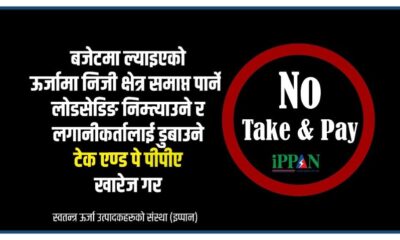
 Blogs8 hours ago
Blogs8 hours agoPrivate Power Producers Protest ‘Take and Pay’ Provision in Budget
-

 Blogs9 hours ago
Blogs9 hours agoNepal Rastra Bank to Withdraw NPR 60 Billion from the Banking System on Monday
-

 Blogs10 hours ago
Blogs10 hours ago52-Week Low & High Microfinance Shares in Nepal: Current Status and Future Outlook
-

 Blogs1 year ago
Blogs1 year agoList of Stock Brokers in Nepal with NEPSE TMS Login – Updated
-

 Blogs10 hours ago
Blogs10 hours agoAsian Life Insurance to Issue Rights Shares from Asar 25
-

 Blogs6 months ago
Blogs6 months agoSiuri Nyadi Power Limited Added to IPO Pipeline by SEBON
-

 Blogs3 months ago
Blogs3 months agoPure Energy IPO For General Public


